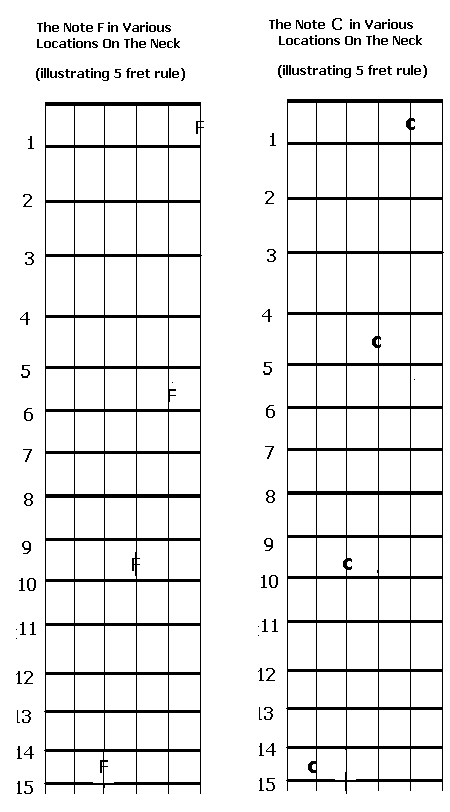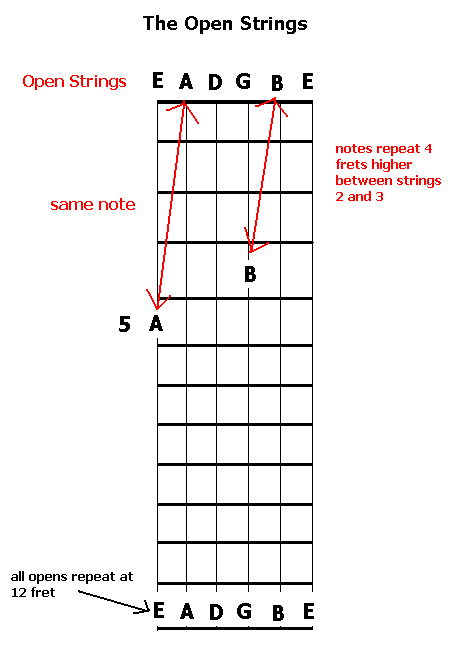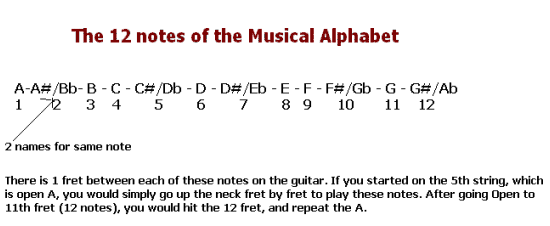Even though I always recommend students to learn to read notes on the guitar, the simple fact is that many guitar players never do learn to read, and moreover, reading notes is not necessary for greatness as a guitarist. I have also always felt that a player who does not read should not be excluded from learning the fingerboard in a musical way. And so, I have devised various ways of teaching students who do not read music on the guitar to understand the neck in a musical way.
All good players figure out the neck, one way or another, to a greater or lesser degree. You have to, in order to learn to improvise, arrange, and so forth. Still, many students have trouble with this subject, and it is often due to a lack of understanding the basic logic of the layout of the neck. I want to give you that basic understanding, not only for your general musicianship, but so that you can do the many drills and exercises associated with learning the triads I have given you, and the ones to follow.
The most important facts to firmly grasp are these:
1) There is always one fret distance between all B's and C's on the neck, and also between all E's and F's.
2) All open string notes repeat at the 12th fret, and you must memorize the open strings.
3) Any note can be played on the next lower string 5 frets higher on the neck, except between strings 2 and 3, where it is 4 notes higher.
Armed with these facts, you can locate any note on the neck, as long as you know the names of the open strings. You can also find the same note in many different locations. Let's look at some practical examples.
Illustration: If you know that the 3rd fret of the 1st string is G, then you can play that same G on the next lower string, the 2nd string, by using the 5 fret rule, and adding 5 to 3. So, that G is also on the 2nd string at the 8th fret.
If you know that C# is on the 2nd fret of the 2nd string, then that same C# can be played on the next lower string, the 3rd, by adding 4 to 2. So, that C# is also found on the 3rd string, 6th fret.
Here are a few pictures to drive the point home:

One of the Golden Rules of Teaching is to never take anything for
granted, so I will not assume that everyone actually knows the names of all the open
strings on the guitar! So, just in case you don't, or are a little shaky in your
understanding, here they are:

And, notice the supremely important fact that all the open strings repeat at the 12 fret. You should always be thinking of the neck in this way when you practice, and not just as a vast wasteland once you get past the 3rd or 4th fret. It is all very logical and orderly, and not very complicated (because I wouldn't understand it if it were, either!).
Open is 12 Rule: As you can see the open string notes repeat at the 12th fret. We use the fact that the open notes repeat at the 12th fret to unlock the mystery of the neck beyond the 12th fret. We simply consider the 13 fret, and visualize it in our minds, as if it were the 1st fret of the same string. So, when I think of the 13th fret of the 3rd string, I think of the 1st fret of the 3rd string. It is G#. At the 13th fret, it will be an octave higher than at the first, that's all. (That immediately tells me as well that it is the same as the G# on the 4th fret of the 1st string, since that is the next higher G#, regardless of where it might be).
If you are high on the neck, and need to find that same letter name note down an octave on the same string, you can do it by subtracting 12 from the higher fret, and play the resulting number fret on the same string. So, the F# on the 16th fret of the 4th string is played an octave lower on the 4th fret of the 4th string. Then I can use the 5 fret rule and play the same octave note on the 5th string at the 9th fret. In this way, I can find all F#'s on each string.
Learn To Re-Locate The Geography Of The Neck: As you learn any part of the neck, say the first 3 frets of the 1st string, immediately, in your mind, consider that the 6th, 7th and 8th frets of the 2nd string are exactly the same. It is not a matter of learning all the frets on the neck, it is a matter of understanding the relationships, and then applying each little piece of information to the rest of the neck.
One of the unique features of the guitar, one that makes it more complicated than many instruements, and more versatile as well, is the fact that one note can be played in 2, 3,4, or sometimes 5 different places on the neck. This has tremendous implications for everything we do, or want to do, on the guitar. The only notes that can be played in only one place are the 5 lowest notes of the guitar, the G#, G, F#, F, and low E.
Integration Exercise: If you are not able to instantly locate any note on the neck, then you need work in this area. For instance, if I said "play the not F# on every string, from the 1st to the 6th, you should be able to do it, whether you read notes on the neck or not.
So, if you can't do this, then do these daily drills until you can, and don't worry if it takes a few weeks or even months to start to sink in, that is normal. Just give it 5 minutes a day, that'll do it.
Drill: Choose a note at random from the musical alphabet. Using the "5 fret rule" and the "Open is 12" rule , find it on each string, starting from the first.

Jamie Andreas is a virtuoso classical guitarist from New York.
She started playing guitar at age 14, by 17 she was giving concerts and teaching guitar.